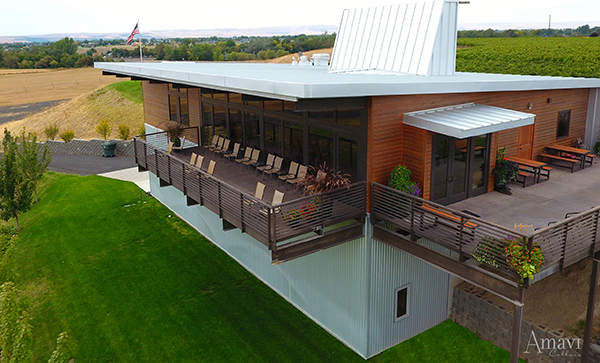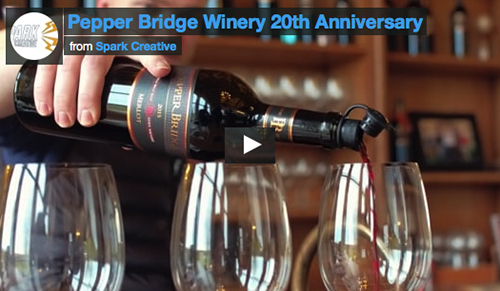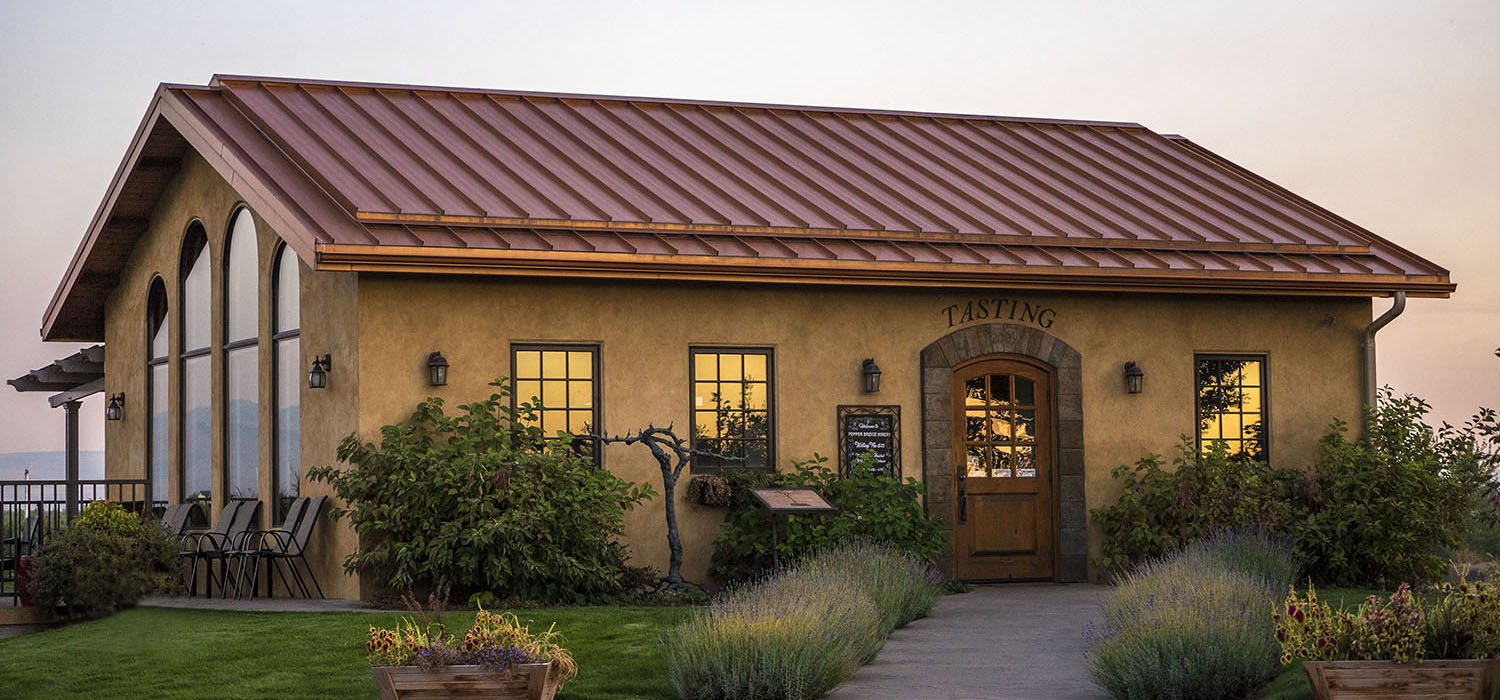Pepper Bridge Winery: In just 20 years, it has made a major impact on Walla Walla’s winemaking industry.
Norm McKibben, Jean-François Pellet and Ray Goff collaborate to create one of the Valley’s premier grape-growing and wine making-operations.
By Kent Settle
Pepper Bridge Winery, one of the Walla Walla Valley’s premiere wineries, turned 20 this year. Yet, with so much of the valley’s winemaking history woven in and around the Pepper Bridge name, it seems surprising that the winery hasn’t been around much longer.
The winery is owned and operated by three families – the McKibbens, the Goffs and the Pellets. I had the recent pleasure of sitting down with two icons of the Walla Walla Valley wine industry – Norm McKibben and Jean-François Pellet.
Listening to these two gentlemen tell their stories, a couple of things become apparent. First is that these men really love not only what they are doing, but they love doing it together. The second revelation is how integral a role each has played in the development of the wine industry in the valley.

Norm McKibben (left) and Jean-François Pellet not only love what they do, but they love doing it together.
Norm McKibben
It all started with Norm – “Stormin’ Norman” – a nod to his relentless drive and energy. Norm McKibben was a successful civil engineer and president of a major construction company who retired in 1985 so he no longer had to travel so much. He and his family moved to the Walla Walla Valley where he had lived in the 1970s.
Soon thereafter, he was just intending to help out a couple of friends who owned a struggling apple packing house business, and Norm became an apple farmer. As he worked to build the apple orchard business, he met winemaking legend Mike Hogue. In 1989, Norm invested in the up and coming Hogue Cellars. Norm recalls that Mike convinced him to plant some sparkling wine grapes on ranch land he owned between Dayton and Waitsburg. This vineyard was “a disaster” according to Norm, and they tore it out after nine years. During this time Norm also became involved with a local investment group that planted Canoe Ridge Vineyard in the Horse Heaven Hills and went on to build the Canoe Ridge Winery in Walla Walla. He also worked closely with several of Walla Walla’s leading vintners.
In 1991, Norm decided to plant 5 acres of Cabernet Sauvignon and 5 acres of Merlot adjacent to his family’s apple orchard just south of Walla Walla. This land is located very close to a key crossing over the Walla Walla River that was owned by the Pepper family. Today, Peppers Bridge Road still runs through the area and lends its name to both Pepper Bridge Winery and the Pepper Bridge Vineyard.
Within a week of the vines going into the ground, Marty Clubb of L’Ecole No. 41 approached Norm to buy fruit from this new vineyard. However, by then, all of the future grapes had already been sold to Gary Figgins of Leonetti Cellar, Rick Small of Woodward Canyon Winery, and Andrew Will Winery. By the next year, L’Ecole was able to purchase one acre each of Cabernet Sauvignon and Merlot grapes from the vineyard.
By 1996, in partnership with Gary Figgins and Marty Clubb, Norm had increased his Pepper Bridge Vineyard holding to 200 acres. While Norm still owns much of the ground beneath the vines, Pepper Bridge Vineyard itself has been sold to another investment group. However, the vineyard continues to be managed by Tom Waliser, who has done so since the vines were planted.
Always looking for more vineyard land to invest in, Norm purchased a 20-acre vineyard called Seven Hills in 1994. The vineyard, less than 10 miles south of Pepper Bridge on the Oregon side of the Walla Walla Valley AVA, was originally planted in 1980. Before long, Norm partnered with Gary Figgins and Marty Clubb in the Seven Hills Vineyard, and by 1998 they expanded the original 20-acre vineyard to over 200 acres.
The year 1998 was an eventful year for Norm. The Washington Association of Wine Grape Growers named Norm the “Grape Grower of the Year.” He was also appointed chair of the Washington State Wine Commission, where he served until retiring from that organization in 2001. 1998 was also the year that Norm’s itch to start his own winery got off the ground. Pepper Bridge Winery was born, with Mike Hogue as a silent partner. It became the 18th winery in the Walla Walla Valley.
That same year, Norm was introduced to Ray Goff, a 30 -year Anheuser-Busch veteran, by Mike Hogue. Ray’s love of wine, vast agricultural experience and a Master’s degree in Industrial Engineering led to Norm adding Ray to the partnership. Ray’s job was to design and build Pepper Bridge Winery. What they were missing at this point was a winemaker.
Norm was not finished acquiring vineyards around the valley, though. He had been trying to buy 100 acres near the Seven Hills Vineyard for years. It was owned by the LDS church and they would not sell him the land if he was going to use it to plant wine grapes.
In the meantime, in 2002, Norm and his son Shane established the Les Collines Vineyard five miles to the east of Pepper Bridge. Norm, however, persisted in his pursuit of the land owned by the church. They agreed to sell under the condition that he buy the entire 2,000 acre parcel of land they owned. Norm agreed to the condition and bought the land. He then contacted his business partners and proclaimed “guess what I just did?” This was the beginning of SeVein Vineyards, a collection of some of the most technologically advanced vineyard properties in the Walla Walla Valley.
Jean-François Pellet
Norm was traveling through California’s Napa Valley in 1999. He had heard about a young Swiss winemaker working at Joseph Heitz Cellars. Jean-François Pellet was a third-generation winemaker from a Swiss grape growing family who held degrees in viticulture and enology. He had been on a whirlwind tour, managing vineyards and making wine around the world – in Switzerland, Germany, Spain and now Napa.
Jean-François never seemed to stay put for more than a year or two, but that didn’t stop Norm from recruiting him to become the winemaker for Pepper Bridge Winery. Jean-François agreed to come to Walla Walla and make wines for two years.
When Jean-François Pellet arrived in Walla Walla for the first time he thought “It was like a tumbleweed town. There was no place to eat!” Driving toward town he remarked regretfully to his wife, Katherine, “it’s all just wheat.” That was 20 years ago and Jean-François is still making wine for Pepper Bridge. He admits that he has great freedom to do things that many of his friends who remained in Europe do not have. “Their fathers are still telling them how to do things,” says Jean-François.
“This is a great adventure,” Jean-François proclaims. “Walla Walla impressed me right away as an extremely unique grape-growing area. Distinctive climate, soils and geography make it different than anywhere else in the world, and now we have the chance to incorporate the latest winery design and techniques with very high-quality grapes.”

Surrounded by Pepper Bridge Vineyard’s acres of estate grapevines, Pepper Bridge Winery’s production facility is built into the side of a hill with three different levels within the facility. Designed by Ray Goff, the facility was the first gravity-flow, wine-production system built in Washington state.
In addition to being the winemaker and partner in Pepper Bridge Winery, Jean-François plays a key role in the management of the winery’s estate vineyards. He is also managing partner in Octave Vineyard in the Walla Walla Valley, has partnered with Rick Middleton and Norm McKibben in Artifex, a custom-crush facility, is a partner in a mobile bottling company with John Abbot, and co-founded Vinea: The Winegrowers’ Sustainable Trust.
Pepper Bridge Winery Wines
Pepper Bridge Winery is built into a hillside, surrounded by the beautiful Pepper Bridge Vineyard, with three different levels within the production facility. They were the first Washington state winery to build a state of the art, gravity flow facility. To this day there is still only one other.
The gravity-flow system allows the grape pulp and juice to move from the sorting table to the tanks to the barrels using nothing more than gravity. By not utilizing pumps, this minimizes shearing of seeds and the introduction of bitter tannins, resulting in exquisitely smooth and elegant wines. Jean-François was also the consulting developer of a new optical sorter, allowing for more uniform grape sorting and improving the overall quality of the wines.
The result of all of this attention to detail and functionality built into the winery allows Jean-François and his staff to focus on creating elegant wines that showcase the winery’s estate vineyards. Their three main wines are Cabernet Sauvignon, Merlot and a Bordeaux-style blend called ‘Trine’ – a nod to the three families who are partnered in the winery. They also make small amounts of Sauvignon Blanc and two, vineyard-designate blends offered only to wine club members.
The day I visited the winery, I tasted the 2014 and 2015 Cabernet Sauvignon, 2015 Merlot and the 2015 Trine. Both of the Cab Sauvs are big, bold and beautifully layered wines with dark fruit front and center. They nicely balance between acidity and rich tannin structure. The Merlot is again a complex wine with layers of dark fruit leading to a nicely spiced finish. The Trine serves up a mix of cherry and raspberry with hints of black tea and licorice. All of these wines will cellar well for years, and would pair well with many hearty foods.

Just down the road from Pepper Bridge Winery, you’ll find the ultra-modern tasting room for Amavi Cellars, the brain child of Norm McKibben and Jean-François Pellet that focuses on producing 100% Estate, 100% sustainable and 100% Walla Walla Valley Syrah and Cabernet wines.
Amavi Cellars Wines
Soon after Pepper Bridge Winery opened, it was becoming apparent that the Walla Walla Valley was becoming very good at growing premium Syrah grapes. Pepper Bridge’s focus was on producing estate, Bordeaux style wines. Syrah is not a Bordeaux grape, so the partners had a decision to make – expand Pepper Bridge’s philosophy or open a second winery. And, thus, Amavi Cellars was born. As Norm put it, an entire business school class could probably be created around that decision.
Similar to Pepper Bridge, Amavi Cellars is dedicated to producing 100% estate, 100% sustainable and 100% Walla Walla Valley wines that showcase the distinct characteristics of this premium wine growing region. They produce wonderfully approachable wines that are moderately priced, yet of premium quality. While their focus is on Syrah and Cabernet Sauvignon, they also produce small amounts of Sémillon, Cabernet Franc Rosé and dessert wines usually reserved for the tasting room.
Amavi Cellars tasting room is a beautiful space overlooking the Pepper Bridge Vineyards and the Blue Mountains to the east. The 2017 Sémillon is a perfect summer wine, clean and crisp, beautifully balanced, while the 2017 Cabernet Franc Rosé was a wonderful surprise. Hints of a strawberry rhubarb pie, a smooth and lingering finish – a very complex wine. Both the 2015 Cabernet Sauvignon and the 2016 Syrah showcased dark, rich fruit, and would stand up against most any hearty meal.
If you’ve never been to Pepper Bridge or Amavi, I highly recommend both wineries. The wines are beautiful, the views are gorgeous and the people are just plain nice. Should you have the pleasure of meeting and speaking with Norm McKibben or Jean-François Pellet, you are in for a treat.

Pepper Bridge Winery is located at 1704 JB George Rd, Walla Walla, WA 99362. For tasting room hours, call (509) 525-6502, or visit: www.pepperbridge.com. Amavi Cellars is located just down the road from Pepper Bridge Winery at 3796 Peppers Bridge Rd, Walla Walla, WA 99362. For tasting room hours call: (509) 525-3541, or visit: www.amavicellars.com.
If you can’t make it out to Walla Walla, both Pepper Bridge and Amavi Cellars also have tasting rooms in the Seattle suburb of Woodinville, WA. They share a tasting rooms at 14810 NE 145th St, Building A-3, Woodinville, WA 98072. For tasting room hours, call (425) 483-7026. Or you can visit the websites of either winery: www.pepperbridge.com; www.amavicellars.com.
EDITOR’S NOTE: Kent Settle writes a great blog covering the Walla Walla wine scene called “WallaWallaWineAmbassador.com” Make sure to check it out.


